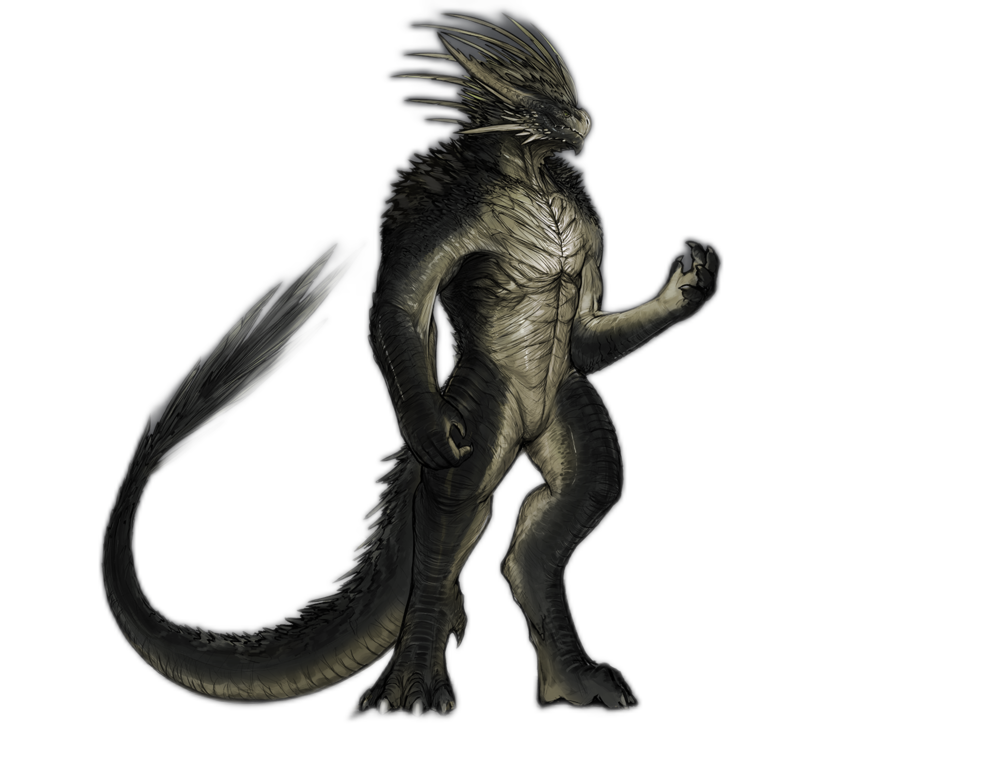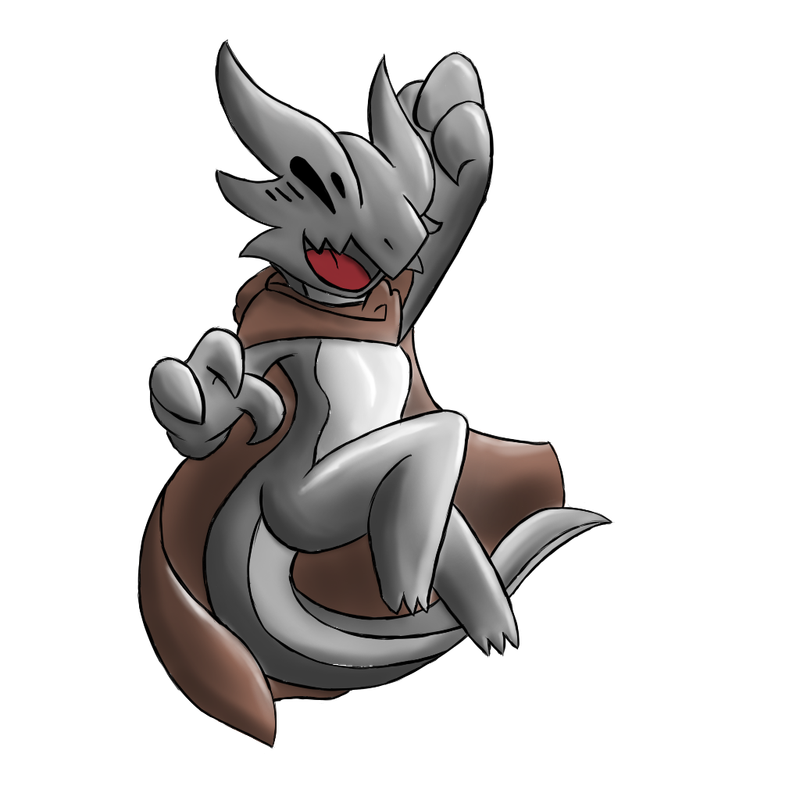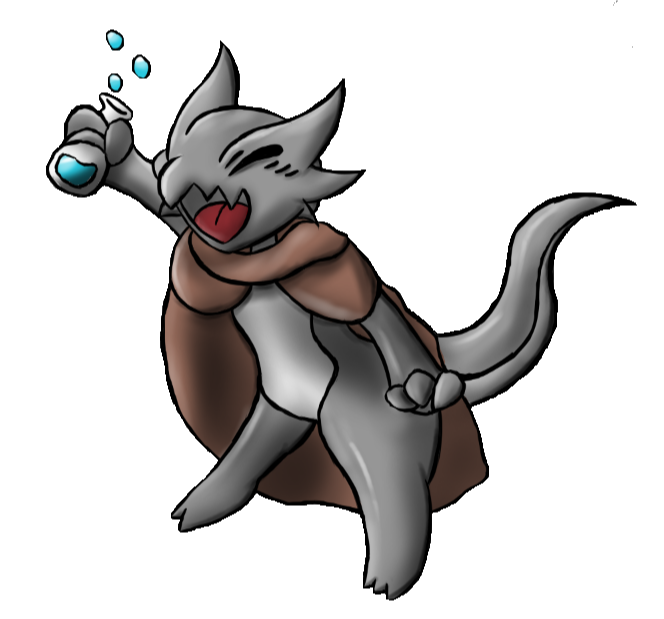Dungeons and Dragons is no stranger to bestial races, so it should be no surprise of their appearance here. However, due to the… generally uninteresting aspects of said beast races, it would generally be more beneficial to merge them as subraces into one, overarching race. Reptilioids are the third group of beastkin, combining any of the non-draconic reptile races, such as Lizardfolk, as well as a few originals.
Reptiloids
Reptilioids, despite being fairly widespread, are quite rare to find due to their more elusive nature, and can often be found in their own tribes, deep within mountains, caverns, or forests, banded together to hunt and survive. Reptilioids are far more endurant than other beastkin types, and they make great use of this fact.
Reptilioid Traits
As a reptilioid, you have the following traits.
Ability Score Increase. Choose one of: (a) Choose any +2; choose any other +1 (b) Choose three different +1
Age. Reptilioids reach maturity around age 14 and rarely live longer than 60 years. Tortilids are an exception, being able to live up to 300 years.
Creature Type. You are a Humanoid. You are considered a beast for the purposes of fulfilling prerequisites or effects that require you to be a beast.
Size. Due to the high variance in subspecies, you you are either Small or Medium (you choose when you select this race).
Speed. Your base walking speed is 30 feet. Additionally, you have a swimming speed equal to your walking speed.
Thermalsense. You can see the heat of other creatures, letting you more or less see any creature that is obscured, in dim light, or in darkness, out to 60 feet. You cannot see Undead or Constructs, due to them not naturally radiating body heat.
Reptilian Resilience. You can hold your breath for a number of hours equal to 1 + your Constitution modifier (minimum of 1) instead of minutes.
Additionally, you have resistance to poison damage and advantage on saving throws against poison.
Scaly Armor. All reptilioids have thick scales. While you are not wearing armor, your AC equals 13 + your Constitution modifier. You can use your natural armor to determine your AC if the armor you wear would leave you with a lower AC. A shield’s benefits apply as normal while you use your natural armor.
Keen Smell. You gain a +3 bonus on Wisdom (Perception) checks that rely on smell. Additionally, dim light does not impose disadvantage on your Wisdom (Perception) checks and attack rolls.
Languages. You can speak, read, and write Common and a language that you and your DM agree is appropriate for the character.
Subspecies. Multiple subspecies of reptilioid exist: chamelo, crocilian, geckan, seropose, and tortilids.
Chamelo
Chamelos, or simply chameleons, easily live up to their name, being able to quickly adapt and camouflage into their surroundings, out of sight. Chamelos are generally the most elusive of the reptilioids as a result of this.
Camouflage. As an action, you can change the color of your carapace to match the color and texture of your surroundings, giving you advantage on Dexterity (Stealth) checks made to hide in those surroundings.
Full Vision. Your eyes can pivot and focus independently, granting you a wide degree of vision. Your bonus from your Keen Smell trait also applies to sight, and you cannot be surprised while conscious.
Prehensile Tail. You have a naturally prehensile tail, granting you extra grip. Your tail can hold up to 20 pounds at a time, and effectively acts as a third arm. Your tail cannot be used to attack or cast spells.
Ballistic Tongue. You have a long tongue that you can shoot out at high speeds. When you make a weapon attack or unarmed strike, you can replace that attack with your tongue. Your tongue is a melee weapon attack which you can use your Dexterity for instead of Strength, and has a reach of 15 feet. On a hit, your tongue deals 1d8 bludgoening damage and grapples and restrains the target of the attack until you either use this trait again, until you retract your tongue (no action required), or until the target breaks free, using its action to make a Strength (Athletics) check contested by your Strength (Athletics), breaking free on a success.
You can only have on creature restrained and grappled by your tongue at a time - if you use this trait again, the previous creature, if any, that was grappled and restrained by your tongue is no longer grappled or restrained.
Crocilian
Crocilians is the unified name that refers to both crocodile and alligator reptiloids. Crocilians are often far tougher and more focused on brute strength than other reptiloids, and have no trouble ripping into a troublesome foe’s hide.
Aquatic Nature. The number of hours you can hold your breath from your Reptilian Resilience trait increases by 2 additional hours, and your swimming speed doubles.
Strongjaw. You have a natural weapon: Your jaws. Your jaws are a melee weapon attack with a reach of 10 feet, and deal 2d8 + your Strength modifier piercing damage on hit. A creature hit by this natural weapon is also grappled by you until you choose to let go (no

… action required), the creature breaks free, or you use this trait again to grapple another creature.
Ripper. Once per turn when, make and unarmed strikes or weapon, you deal additional damage equal to your proficiency bonus.
Hemorrhage. Once on each of your turns when you hit a creature with a melee weapon attack, you can cause the target to bleed until the end of your next turn.
Bleeding
A bleeding target takes 1d6 damage at the start of each of its turns for 1 minute. This damage can not be reduced by any means.
If a target is bleeding, it or another creature can use their action to make a DC 14 Medicine (WIS) check to staunch the bleeding, thus removing the condition. Any healing will also remove the bleeding condition.
Undead, constructs, and creatures that don’t have blood are immune to bleeding.
Geckan
Geckans are climbers, always found in the trees or otherwise above ground, moving swiftly across all kinds of surfaces.
Geckan Climb. You gain a climbing speed equal to your walking speed, and can climb on difficult surfaces without requiring a check, including upside down. You must use all your hands when climbing on a difficult surface, though your hands are freed up so long as you are not climbing on the difficult surface at the time (such as stopping in place after moving along a ceiling).
Membranes. You lack eyelids, instead having a special membrane coating your eye, as well as enhancing your night vision. You gain darkvision out to 90 feet, and you are immune to being blinded through nonmagical means.
Geckan Camouflage. As an action, you can change the color of your carapace to match the color and texture of your surroundings, giving you +2 bonus on Dexterity (Stealth) checks made to hide in those surroundings.
Balanced Tail. Your larger and flatter tails helps maintain balance. You have a +3 bonus to saving throws made to avoid being forcefully moved or knocked prone against your will.
Serpose
Serpose, serposents for plural, are a group of snakefolk, moving around as normal. Like snakes, the serpose are slippery and quick, striking in the blink of an eye when provoked. Many serpose also have some form of venom, and almost all share the same blindsense that snakes have.
Viper’s Movement. Your movement speed increases by 5 feet and you can Dash as a bonus action.
Serposian Venom. You can secrete a venom as a bonus action, enough to fill a small flask, to coat a weapon of some sort, or to coat up to 20 pieces of ammunition. This venom can be stored indefinitely if filling a flask, or lasts for 10 minutes if coating a weapon or ammunition. Coated weapons and ammunition deal an additional 1d10 poison damage on hit.
Once you have secreted this venom, you cannot do so again until you finish a short or long rest.
Snakesense. Like the snakes, you have a higher degree of sensing your surroundings, granting you blindsight out to 20 feet.
Prehensile Tail. You have a naturally prehensile tail, granting you extra grip. Your tail can hold up to 20 pounds at a time, and effectively acts as a third arm. Your tail cannot be used to attack or cast spells.


Derek Hetrick Art
Tortilid
Tortilids are cousins to the tortles, serving as the more land-borne relatives. As such, tortilids do share a few similar traits, namely their shell, but otherwise are quite different in biology.
Natural Armor. Your shell provides you a base AC of 17 (your Dexterity modifier doesn’t affect this number). You can’t wear light, medium, or heavy armor, but if you are using a shield, you can apply the shield’s bonus as normal.
Shell Defense. You can withdraw into your shell as an action. Until you emerge, you gain a +4 bonus to your AC, and you have advantage on Strength and Constitution saving throws. While in your shell, your speed is 0 and can’t increase, and you have disadvantage on Dexterity saving throws. You are also unable to cast spells while in your shell, but you may continue to make weapon attacks as usual.
Heavy Lifter. You count as one size larger when determining your carrying capacity and the weight you can push, drag, or lift. Additionally, you do not suffer disadvantage when wielding oversized weaponry, nor do you suffer disadvantage with a weapon as a result of the weapon having the Heavy property.
Breaker. You deal double damage to objects and structures.



tamiart






